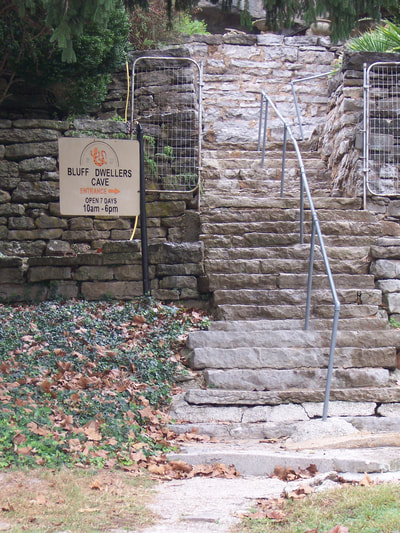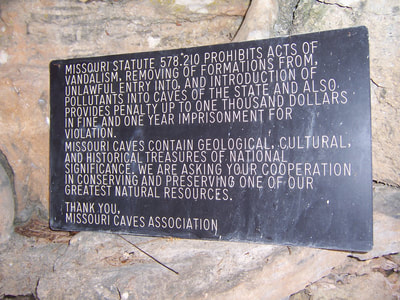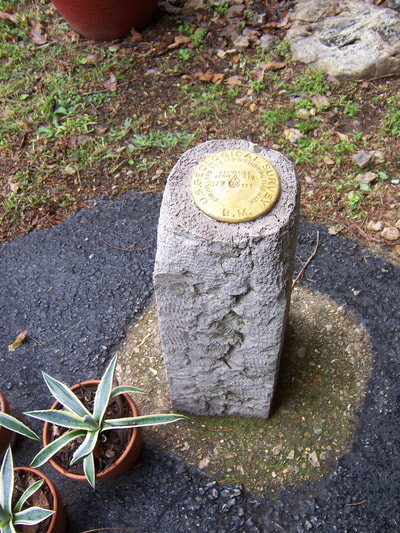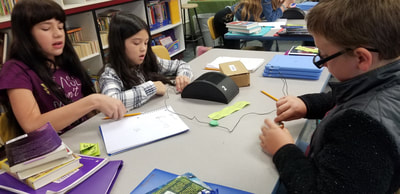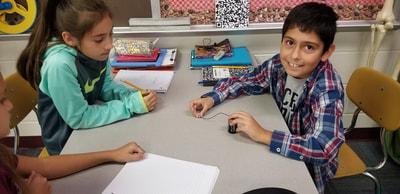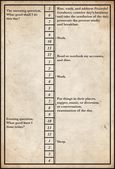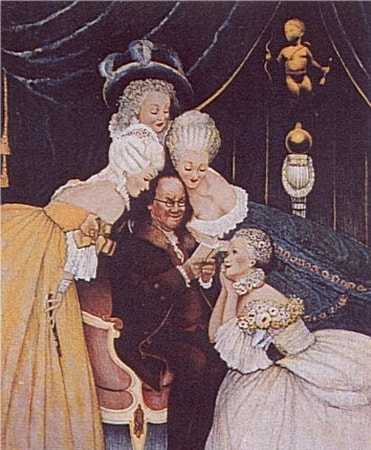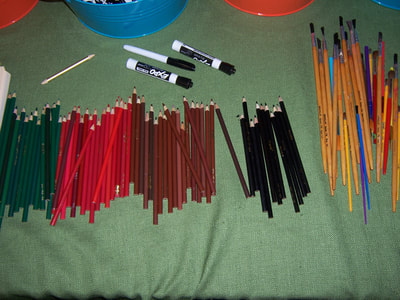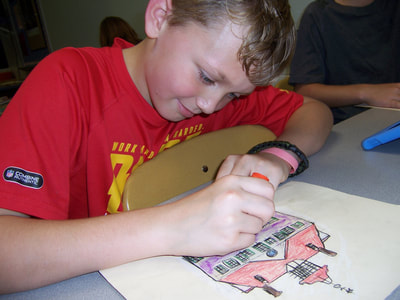|
Last Friday's field trip took the class to Bluff Dweller's Cave in Noel, Missouri. We spent a good deal of time on waiting before entering the gift shop and museum, more waiting between the museum and the cave, and then, finally, some waiting after our lunch. For the times in between, I'll be posting some more photos in the next couple of days. In the meantime, for today, here are our shots from outside the museum and cave.
0 Comments
Last week was an eventful one, as we began to learn about Benjamin Franklin. A part of that study must include Franklin's foray into the world of electricity. That was our signal to begin a little unit about electrical circuits, a part of which was to find ways to complete a circuit and light up a bulb.
It's time to take back your power. Take five and a half minutes to watch this video. Now for some questions:
Mood Music
 In 1780, Joseph Plumb Martin reports nearly "taking another final discharge from the army in consequence of my indiscretion and levity". It seems the men created a sport out of copying the motions of a flying squirrel. Coming across a few smallish trees measuring "three, four, or five inches diameter at their butts, and many of them were fifty or sixty feet in height". A man would climb as far as a tree would allow, and when the tree bent from their weight, it would catapult the man into the air. I'm not sure how this must have looked, but it doesn't sound like a strong choice of behavior. In fact, it seems more than slightly dangerous. As if to emphasize my point, Martin writes that he "would have one capital swing". Climbing farther than before. He relates that the tree bent "to about a horizontal position" before "it snapped off as short as a pipestem", dropping him an estimated 40 feet to the ground. "I brought it with all the force of my weight and its own directly upon the top of my unthinking skull, which knocked me as stiff as a ringbolt, he says. Kids, please don't try this at home...or anywhere else for that matter. It sounds like Martin's headache lasted for several days and he got in trouble to his behavior choice.  We've all seen the painting of Washington crossing the Delaware River on Christmas Day in 1776. He stands there among his soldiers in the boat, floating across the icy water. We might even think we know a little about that Christmas night attack on the Hessians in Trenton, New Jersey - the battle that turned the tide for the Americans. There is a little piece of the story that I didn't know until I read the center pages of Edward Lengel's book, General George Washington. It might have been there the whole time, and it just failed to register with me. There, in Trenton, the Colonel Johann Rall, leader of the Hessian soldiers, was killed in the battle. Drawing his last breaths, he talked directly to the American general, Washington. That's right, our George Washington, the commander-in-chief of the Continental army, consoled an enemy colonel on his deathbed. The German asked the American to treat his soldiers, now prisoners of the Patriots, well. Shortly after, before shipping the Hessian soldiers to prison, George Washington treated some of them to a dinner, where he impressed them as a very affable gentleman. They were intrigued by how polite and refined Washington was, but they also made note that he was not the marble-statue-of-a-god that they had envisioned. George had been defined in media and gossip as being larger than life, but these men couldn't help but note that he was generally a nice fellow, very amiable. Perhaps they knew that he had comforted their leader as the clock of his life ran down. Maybe they read the expressions on his face and understood George's desire to end the war and live the life of a regular citizen. Later, Patriot soldiers found their own peers stripped and pillaged by British troops, they wanted to do likewise to the British troops. When General Washington found his soldiers stripping and robbing British corpses, he immediately put a stop to the action. Not only that, the commander-in-chief had some of the injured enemy soldiers taken to domestic houses nearby to receive medical care. Others, more seriously injured, were delivered to doctors, like Dr. Rush himself, where they received amputations they needed. These scenes of humanity should not be left in the past. How might they be applied in the lives of fourth graders?
I can only imagine how hard it was to fight a man in one instance and console him with compassion and empathy in the next. George Washington is often described as a man who does not wear his heart on his sleeves, a man who keeps his emotions in check, but his humanity shines through in the most unlikely places. Sticks and stones may break my bones, but words will never hurt me. Is that saying old fashioned? Is it true? It may be time to think about reinforcing it for a new generation. Take seven minutes to watch this video. Now for some questions:
In our continued effort to cross curricula whenever possible, once again we found George Washington creeping into our math lessons, this week. Before he did, however, we pulled out these awesome purply plasticky tools called Reflectotrons. Or are they Reflectometers? Reflectrix? Anyway, when utilized properly, these nifty pieces of plastic reflect an image on one side onto the other, allowing one to trace the reflection or make a symmetrical design. Following that work, students started to understand George Washington's updated design for his mansion and plantation in Virginia. It seems there is a great deal of symmetry built into the property there as indicated in the overall look of the mansion. Students drew the mansion with as much attention to detail as possible (and a lot of instruction).
Finally, returning to those cool, plastic Reflectomatic devices, students had the opportunity to complete a symmetrical portrait of George Washington himself.
I am recording this post after eating a large meal - ribs, brisket, pulled pork, a roll, onion rings, and sweet potato fried. I am already miserable from eating too much, and then read this paragraph about Revolutionary War soldiers starving over a difficult winter. It just emphasizes the abundance for which we should be thankful and not take for granted.
Art AppreciationAnalyze the artworks shown below. Check out the details.
"Man" Your Post
Cannon Time
 In classrooms across the U.S., teachers are neglecting - teachers are often encouraged to neglect - certain portions of the curriculum. What used to be important - teaching science and social studies - has again been reduced to The Three Rs - Readin', 'wRitin;, and aRithmetic (or math). When a teacher recognizes the exclusion of history, the response might be, Teach history during your reading block; in other words, locate age-appropriate writings to read (and respond to) to demonstrate comprehension and fluency. Ouch. You just succeeded in sucking the life out of one of the coolest part of the day...and you may have just sucked the fun out of reading, as well. The same is done with science. While we may recognize that science is part of the acronym for STEM or STEAM, once again, it has been relegated to some kind of secondary status. Then again, just like social studies, science must never be put in the corner only to be pulled onto the dance floor in conjunction with reading. What a way to kill the desire for reading. Both history and science are about stories, and yes, both can be used to teach reading comprehension, but neither should be the secondary objective. These are the subjects of substance. They are robust. And they are compelling to students. When a teacher relates of an interesting account in history, he hooks students and makes them want to learn more. When that motivation is removed, what remains? School becomes boring. Friends, may we strive to never let that happen: do not neglect the good stuff.  Here's another observation from General George Washington, by Edward G. Lengel. There seems to be a pattern that contrasts our first commander-in-chief leading the Continentals from General Howe leading the British. In the weeks and months before the famous Delaware River crossing and the surprise Christmas attack in Trenton, New Jersey, Washington retreated often. That is, in consultation with his leadership team, he withdrew troops to avoid a loss of life or a physical and emotional defeat. When he did so, Washington made the effort to pick up as many supplies and weaponry as his men could carry; they didn't ever want to leave something useful behind. In contrast, General Howe and his thousands of soldiers often left behind cannon or other materials that were subsequently collected by the Patriots. Almost immediately, the Continental army had more to work with, either using the British weapons against them or destroying pieces that were more trouble than they were worth. It may be one reason for the penultimate victory for the fledgling nation. I am reminded of a certain fourth grade classroom, in which students often leave things behind to be used by others or to be destroyed. There is definitely a lesson or two to be gleaned from Washington's tactics on the battlefield in 1776:
During those days George Washington often made the wrong choices, but so did General Howe. Neither knew what would happen in the near future, and neither knew what the other had planned. They always had to be ready to face whatever was thrown (or shot) in their direction. They had to learn along the way. For the Continentals, that meant they had to learn to fight in new ways, improvising their attacks and strategies to defeat what should have been a much-superior army. In our classroom, we don't fight enemies, but we do conquer the unknown. We adapt to new situations and concepts, and we learn from our mistakes. Isn't it interesting how much a study of George Washington can teach us about ourselves? Joseph Plumb Martin had a little fun in my latest reading from Memoir of a Revolutionary Soldier. He and his buddies collected "a number of bombshells and some old damaged wagon wheels lying near the barracks". They began their shenanigans by filling the shells with water and throwing them in the fire. When the water heated and expanded, the shells "would force the plug out with a report as loud as that of a pistol"
The first step in discovering geometry at Mount Vernon was for students to explore the mansion and property virtually. This week, Mrs. Friend (our student-teacher) begins some rigorous work in symmetry and measurement, implementing formulas and strategies for calculating area and perimeter.
|
AnthemThe Hoggatteer Revolution
is an extensive, award-winning, inimitable, digital platform for Encouraging and Developing the Arts, Sciences, and honest Christianity in the beautiful, friendly LAND OF THE FREE AND THE HOME OF THE BRAVE This site is described as
"a fantastic site... chockablock full of interesting ideas, hilarious anecdotes, and useful resources." 
...to like, bookmark, pin,
tweet, and share about the site... and check in regularly for new material, posted often before DAWN'S EARLY LIGHT! History in ResidenceElementary Schools: Bring Mr. Hoggatt into your classroom for a week of engaging and rigorous history programming with your students. LEARN MORE BUILDING BETTER
|


